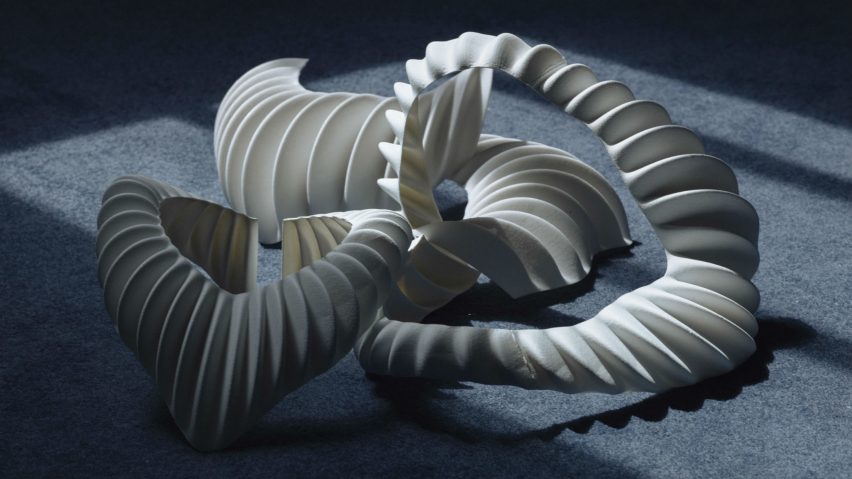Graduate show season is always a highlight in the design calendar and 2018 was no exception. For our review of the year, design reporter Gunseli Yalcinkaya selects 10 of this year's standout student projects, from a portable protest toilet to a portable cooking set.
Royal College of Art graduate Jun Kamei built a 3D-printed garment that functions like fish gills, intended to help humans survive when sea levels inevitably rise up and submerge the earth.
Called Amphibio, the two-part accessory consists of a gill-like chest piece and a respiratory mask. It is designed to allow humans to completely breathe underwater.
Find out more about Amphibio ›
Design Academy Eindhoven graduate Elisa Otañez created a bight yellow, mobile toilet as a protest against the lack of public facilities for women in The Netherlands.
"Men were peeing in public, in corners, in the streets, and they got rewarded with toilets," Otañez told Dezeen. "Do women have to start doing that as well to get their public toilets?"
Find out more about Yellow Spot ›
Bezalel Academy of Art and Design graduate Hadar Neeman's personalised ballet shoes use 3D-printing technology to reduce dancer's pain.
The reimagined ballet shoe is adapted to fit the user's foot, providing comfort and protection. The result is three-times more durable than traditional ballet shoes.
Find out more about P-rouette ›
For his graduation project, Royal College of Art graduate Marcus Kung designed a drone that can fly without propellers, intended to reduce drone-related injuries.
The Impeller Drone flies using four air blowers, as opposed to exposed rotor blades like most drones. The product aims to make drones safer for casual users and bystanders.
Find out more about Impeller Drone ›
Royal College of Art graduate Jiabao Zhang combined the forms of multiple cups, bottles, pens, light shades and reading glasses to create a series of objects that are as average as possible.
For each of her five objects, she measured 50 ready-made examples of "largely anonymous, inexpensive and unexceptional" objects. Her aim was to explore the relationship between form and function.
Find out more about One is Fifty ›
Foreign Garbage by Katie May Boyd
Central Saint Martins graduate Katie May Boyd moulded cats out of waste plastic that she collected from her university over a period of nine months for her final project.
She wanted to create an installation that would draw attention to the inefficiency of plastic waste recycling and chose to focus on a Japanese Maneki-neko cat as a symbol of a mass-produced object that is commonly made in China.
Find out more about Foreign Garbage ›
A Basic Instinct by Anna Aagaard Jensen
Men are not suppopsed to use these chairs by Design Academy Eindhoven graduate Anna Aagaard Jensen. She designed the pieces to challenge social norms and encourage women to claim more space with their bodies.
Each of the three chairs is a different shape that relates to an exaggerated form of the human body and encourages the user to spread their legs to sit.
Find out more about A Basic Instinct ›
Tiger Penis Project by Kuang-Yi Ku
Design Academy Eindhoven graduate Kuang-Yi Ku's Tiger Penis Project is a speculative design that proposes using synthetic biology to create organs that can replace the animal products used in traditional Chinese medicine, including parts from endangered species.
His project explores ways to harness new technologies to create an alternative source of animal products for use in the traditional recipes.
Find out more about Tiger Penis Project ›
Restless Body Furniture by Yuming Hu
Tsinghua University graduate Yuming Hu designed this range of chairs aimed at the peculiar behaviours of its different users.
Focusing on the micro-movements people make after they sit down, Hu wanted to create a range of chairs that focus on the subtleties of body language and gesture.
Find out more about Restless Body Furniture ›
Mobile Journalism by Jim Brady
For his final project, Design Academy Eindhoven graduate Jim Brady created a virtual reality experience that depicts a protest event where visitors are able to change their point of view between riot police, protesters and the media.
"In this age of information, we are quick to form an opinion based on what's published. But there is more than one version to the stories we hear," he explained.
Find out more about Mobile Journalism ›

